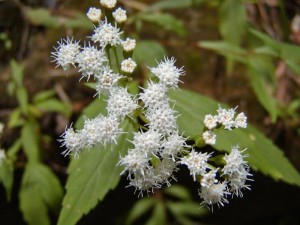 Mistflower (Ageratina riparia: Asteraceae) is a perennial herbaceous alien plant that invades wet habitats,particularly riparian areas and moist cliff faces in eastern Australia. On 21 October 2010, the white-smut fungus Entyloma ageratinae, previously introduced to Hawaii, South Africa and New Zealand for the biological control of mistflower, was found near Lamington National Park, Queensland. Field surveys confirmed that the fungus was widespread in south east Queensland and NSW North Coast and present in the Coffs Harbour region, Mid-North Coast, NSW. It was not found further south in NSW. Host-specificity testing of the fungus on closely-related plant species to mistflower within the Eupatorieae tribe, includingtwo Australian native Adenostemma species, revealed that only the invasive plant crofton weed (Ageratina adenophora) developed some disease symptoms, albeitto a much lesser extent than mistflower.
Mistflower (Ageratina riparia: Asteraceae) is a perennial herbaceous alien plant that invades wet habitats,particularly riparian areas and moist cliff faces in eastern Australia. On 21 October 2010, the white-smut fungus Entyloma ageratinae, previously introduced to Hawaii, South Africa and New Zealand for the biological control of mistflower, was found near Lamington National Park, Queensland. Field surveys confirmed that the fungus was widespread in south east Queensland and NSW North Coast and present in the Coffs Harbour region, Mid-North Coast, NSW. It was not found further south in NSW. Host-specificity testing of the fungus on closely-related plant species to mistflower within the Eupatorieae tribe, includingtwo Australian native Adenostemma species, revealed that only the invasive plant crofton weed (Ageratina adenophora) developed some disease symptoms, albeitto a much lesser extent than mistflower.
Monitoring transects were established at eight sites in NSW and three in Queensland, and baseline vegetation data were collected to enable quantitative assessment of the impact of the fungus in the future.
A series of strategic releases of the fungus to non-infected mistflower sites in NSW were made in May2011. Monitoring sites were revisited in May to July 2012 and a measurable adverse impact of the funguson mistflower was recorded. There was more than 60% decrease in percentage cover of mistflower across sites, with a corresponding increase, by also more than 60%, of the percentage cover of other plant species.
Within a very short timeframe, the project demonstrated that the white-smut fungus has great potentialasa highly effective and self-sustaining control method for mistflower across its range.

